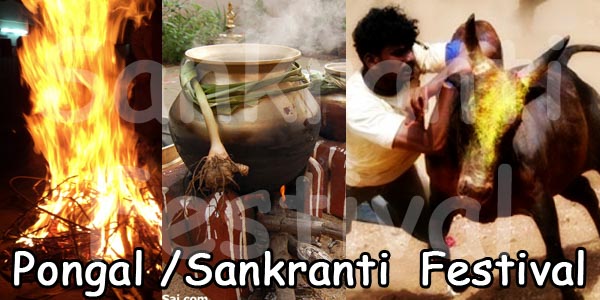People celebrating ‘Pongal’ festival should know meaning and significance of rituals associated with harvest festival. ‘Pongal’ or ‘Thai Pongal’ is also known as ‘Makara Sankaranthi’. Festival is celebrated on first day of ‘Thai’ when the Sun enters ‘Makara Rasi’ (Capricorn). At this time, winter comes to an end and spring arrives throughout northern hemisphere. Following this, during next six months, days become longer and warmer.
This time of year is referred to as ‘Uttarayan Punyakalam’ and it is considered auspicious. According to legend, during this time, Devas wake up after six months of long slumber. Also, it is believed that people who expire during ‘Uttarayana’ attain salvation. Hence, ‘Bheeshma’ waited for the dawn of Uttarayana when he gave up his life.
‘Pongal’ is a four-day festival. The first day, ‘Bhogi’, is celebrated on the last day of Tamil month, ‘Margazhi’. People clean, collect old, unwanted things and burn them and decorate their homes. People are busy with domestic activities. They buy new utensils and vessels. Generally, people spend their time with their family. Scholars often compare ‘Bhogi’ with ‘Indra Vizha’ or ‘Poompuhar’ celebrated by Chola kings at Kaveripattinam. Festival known as ‘Indra Vizha’ was celebrated in honour of Lord Indra. Also, ‘Bhogi’ festival is for honouring Lord Indra, God of thunder and rain.
The second day, ‘Perum Pongal’ or ‘Surya Pongal’ is the most important festival. People worship Surya, the Sun God, and his consorts, Chaya and Samgnya. On this day, women decorate the central courtyard of their homes. Beautiful ‘Kolams’ designs with rice flour and bordered with red clay are created. ‘Pongal’ dish is cooked exactly at the moment when new month arrives. There are several legends associated with ‘Perum Pongal’. Sitting on banks of ‘Pottramarai’ reservoir in ‘Kumbakonam’, Hema, a sage, prayed to Lord Vishnu. On ‘Perum Pongal’ day, Lord Vishnu appeared as Sarangapani and blessed him. Also, there is another legend according to which Lord Shiva performed a miracle. A stone image of an elephant ate a piece of sugarcane.
Third day, ‘Mattu Pongal’ is celebrated to glorify cattle that help farmers in numerous ways. On this day, cows are bathed and decorated with vermilion, garlands and fed. In particular southern Tamil Nadu villages, bullfighting or ‘manji-virattu’ is held in evenings. Ferocious bulls with bags of coins tied to sharp horns are released in open fields. Courageous, brave, young village men compete with each other. They control bulls and retrieve bags of money tied to sharp horns.

According to ancient Tamil literature, men had to subdue the bull to win the hand of a fair maiden. It is believed that even Lord Krishna had to defeat seven bulls before he married Nappinnai. Unlike Spanish bullfighting, in ‘manji-virattu’ no bull is ever killed. Festival of ‘Mattu Pongal’ is not important to urban dwellers who celebrate ‘Kannu Pongal’. Urban women offer special prayers for well-being of their brothers.
Also, Tamils remember Tiruvalluvar, the poet, who was born on ‘Kaanum Pongal’. On this day, families gather on riverbanks to have a splendid meal [‘kootanchoru’]. During this time, traditional dances such as ‘kummi’ and ‘kolattam’ are performed. In recent years, this day is celebrated as ‘Uzhavar Tirunal’ in honour of farmers.
